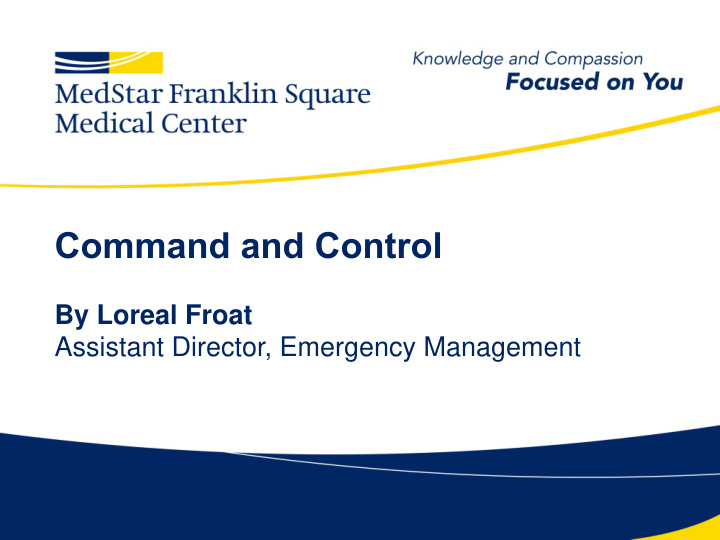



Command and Control By Loreal Froat Assistant Director, Emergency Management
Definition • “The exercise of authority and direction by a properly designated commander over assigned and attached forces in the accomplishment of the mission. Command and control functions are performed through an arrangement of personnel, equipment, communications, facilities, and procedures employed by a commander in planning, directing, coordinating, and controlling forces and operations in the accomplishment of the mission.” • AKA: The framework for decision making and operations related to ACS activation and operations 2 September 12, 2014
State Level Command and Control Governor • Authorize the use of alternate care sites by licensed health care facilities during a declared state of emergency MIEMSS • Coordinate with local jurisdictions regarding the establishment of MIEMSS approved alternate triage protocols and/or temporary patient triage locations • Coordinate patient movement via ambulance • Monitor bed availability and surge capabilities of healthcare entities • Work with unified/area commands and site incident commanders to transfer patients between facilities based on situational awareness
State Level Command and Control DHMH • Coordinate Maryland Professional Volunteer Corps and regional/state/federal health and medical resources. • Provide medical surveillance and public health situational updates to the local level • Implement regional or statewide communicable disease control strategies • Assist with ensuring food safety, environmental safety and sanitation • Request use, in consultation with other partners, of the recognized ACS @ GBMC • Forward requests for; and provide notification of waivers to existing laws and regulations related to public health and patient care • Provide local level health and medical updates • Provide media assistance and participate in Joint Information Center • Approve use of the physical space designated as an alternate care site • Establish approved levels of care at said sites • Coordinate with CMS and assist with submission of CMS EMTALA waivers, as necessary • Perform site visits of alternate care sites as determined by OHCQ • Expedite approvals for hospitals to temporarily exceed bed capacities
Jurisdictional Level • Response begins and ends at the local level and as such, it is the assumption that jurisdictions will have the most current and accurate picture of their capabilities and available resources • Therefore, primary authority for expanding health and medical capabilities, including the activation of alternate care sites, would be at the jurisdictional level, in consultation with DHMH and local health department.
Local Level Command and Control LHD • Establish communication and coordination between ESF 8 partners • Coordinate with DHMH to recruit in-state volunteers • Coordinate with response partners to prepare risk communication messages for the staff, their families, and the general public • Coordinate with response partners to ensure that local messaging, including website material, is consistent • Coordinate with response partners to ensure that a hotline or call center capability exists and could be activated as needed • Participate in planning, activation, and set up of alternate care sites - Maryland Surge Plan Draft, 2009 • Coordinate the activities of the Medical Surge Group and ACS Task Force • Work with the healthcare community to identify who will operate the ACS • Coordinate with OHCQ and healthcare facility to determine scope and level of care, activation, and demobilization • Assist in the coordination and provision of non-operational support (Examples include: volunteer credentialing; staff scheduling; finance/administrative support; logistics support)
Local Level Command and Control LOCAL EOC PARTNERS (non-LHD) – Security – Traffic control – Vehicle coordination – Signage – Public messaging – Volunteer management – Sheltering – Animal Control – Facility acquisition 7 September 12, 2014
Recommend
More recommend